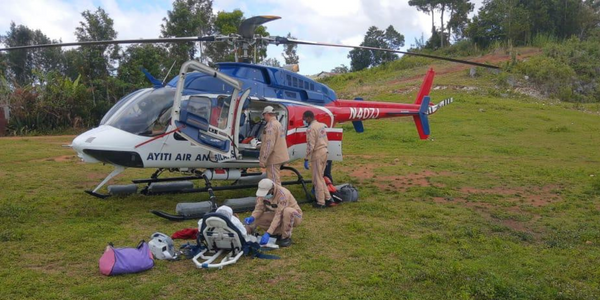Alright folks, buckle up because we’re about to talk about a topic that could quite literally be a matter of life or death. We all know that in medical emergencies, time is of the essence, right? But have you ever stopped to really think about the cost of delay and why speed matters so much? Well, hold on tight as we delve into the world of medical emergencies and explore just why getting help as quickly as possible can make all the difference in the world. So, fasten those seatbelts and get ready to land some knowledge bombs as we dive into “The Cost of Delay: Why Speed Matters in Medical Emergencies.”
Introduction
In medical emergencies, time is of the utmost essence. Every second counts when it comes to saving lives and ensuring the best possible patient outcomes. In this article, we will explore the critical role speed plays in emergency medical care, particularly in the context of air ambulances. We will examine the factors that can affect the speed of medical interventions, the potential consequences of delays, and the ways in which speed can be improved. By understanding the importance of speed and the options available to expedite emergency medical care, you can be better prepared for unexpected situations that may arise.
Understanding the Importance of Speed
The critical role of time in medical emergencies
When faced with a medical emergency, every passing second can make a significant difference in a patient’s outcome. Whether it’s a heart attack, stroke, or severe trauma, timely medical intervention is vital to prevent further complications and save lives. Medical emergencies often involve critical conditions where immediate treatment is the key to preventing irreversible damage or death.
How delays can impact patient outcomes
Delays in emergency medical care can have devastating consequences. A delay in reaching the appropriate healthcare facility or receiving the necessary treatment can lead to worsened patient outcomes, increased risk of morbidity and mortality, and long-term health implications. Time-sensitive conditions, such as cardiac events or severe bleeding, require swift action to maximize the chances of a successful recovery.
The concept of the ‘golden hour’ in emergency medicine
In emergency medicine, there is a concept known as the ‘golden hour.’ This refers to the first 60 minutes after a major traumatic injury or the onset of a severe medical condition. During this crucial period, the prompt and effective provision of medical care significantly improves the chances of a positive outcome. With the passage of time, the window of opportunity narrows, and the potential impact of delays becomes increasingly concerning.
Factors Affecting Speed in Medical Emergencies
Geographical limitations and accessibility
One significant factor that can affect the speed of medical interventions is geographical limitations and accessibility. In rural or remote areas, where medical facilities may be scarce or far away, it can be challenging for emergency medical services (EMS) to reach the scene quickly. The distance and lack of infrastructure can cause delays in providing critical care to patients in need.
Traffic congestion and transportation challenges
In urban settings, traffic congestion poses a significant challenge to the rapid transit of emergency medical teams. Heavy traffic not only limits the speed at which ambulances can navigate through the city but also increases the risk of delays in reaching the hospital. Narrow streets, roadblocks, and other transportation challenges can further hinder quick and efficient movement.
Availability and readiness of emergency medical services
The availability and readiness of emergency medical services (EMS) vary from one location to another. In some areas, there may be a scarcity of well-equipped ambulances and trained medical professionals. Limited resources and personnel shortages can contribute to slower emergency response times and impact the speed at which patients receive critical care.
Air Ambulances: A Swift and Effective Solution
What are air ambulances?
Air ambulances, also known as medical helicopters or aeromedical services, are specially equipped aircraft that are used to transport patients in critical condition. These helicopters are staffed with highly trained medical professionals and equipped with specialized medical equipment to provide advanced care while in transit. Air ambulances enable the swift transportation of patients, bypassing obstacles and traffic that may impede traditional ground transportation.
Advantages of air ambulances in emergencies
Air ambulances offer several advantages in emergency situations. Firstly, they can overcome geographical limitations and access patients in remote or hard-to-reach areas much faster than ground transportation. Additionally, air ambulances are not affected by traffic congestion and can reach their destination swiftly, even in busy urban areas. The ability to land directly at hospitals or other designated landing zones further reduces transportation time, ensuring timely delivery of patients to appropriate medical facilities.
Speed and efficiency of air transportation
Air transportation is inherently faster than ground transportation, making air ambulances a crucial asset in time-sensitive medical emergencies. By flying directly to hospitals or trauma centers, air ambulances significantly reduce the time spent in transit. This expedited transportation allows patients to receive advanced medical care sooner and increases their chances of favorable outcomes. The speed and efficiency of air transportation provided by air ambulances can truly be a game-changer in life-threatening situations.
The Potential Consequences of Delay
Increased risk of morbidity and mortality
Delays in emergency medical care can lead to an increased risk of morbidity and mortality. For example, in cases of severe trauma or cardiac events, every minute that passes without timely medical intervention can result in irreversible damage to vital organs or loss of life. Timeliness in emergency care is critical to minimize the potential complications and adverse outcomes associated with delays.
Long-term health implications
Beyond the immediate risks, delays in emergency medical care can also have long-term health implications for patients. Conditions that could have been effectively treated or managed with prompt intervention may deteriorate over time, leading to chronic health issues, disabilities, or reduced quality of life. Early access to appropriate care can help prevent such long-term implications and maximize the chances of complete recovery.
Financial burdens on patients and healthcare systems
Delays in emergency medical care not only impact patient health but also impose financial burdens on both individuals and healthcare systems. Prolonged hospital stays, additional treatments, and prolonged rehabilitation due to delayed interventions contribute to increased healthcare costs. Moreover, delayed care can result in productivity losses for patients and their families due to extended recovery periods, further adding to the financial strain.
Case Studies: Real-World Examples
Successful air ambulance interventions
Numerous case studies highlight the successful interventions of air ambulances in saving lives and improving patient outcomes. In situations where ground transportation would have been time-consuming or impossible, air ambulances have played a crucial role in swiftly transporting patients to medical facilities equipped to handle their specific needs. These stories underscore the critical importance of speed and the unique capabilities air ambulances possess in emergency situations.
Cases where delays resulted in adverse outcomes
Tragically, there have also been instances where delays in emergency medical care resulted in adverse outcomes. These cases highlight the potential consequences of delays and emphasize the need for efficient and expedited interventions. By examining these situations, we can learn from the past and strive for continuous improvement in emergency medical services to minimize delays and their detrimental effects.
Improving Speed in Emergency Medical Care
Investments in infrastructure and technology
To improve the speed of emergency medical care, investments in infrastructure and technology are crucial. Building and maintaining well-equipped hospitals, trauma centers, and EMS stations in strategic locations can reduce the time it takes to reach patients and initiate treatment. Additionally, embracing technological advancements, such as robust communication systems and real-time tracking, can enhance the coordination and efficiency of emergency medical services.
Training and education for healthcare professionals
Ensuring that healthcare professionals are adequately trained and educated in emergency medical care is essential for speed and effectiveness. Regular training sessions and continuing education programs can equip healthcare providers with the skills and knowledge necessary to act swiftly and confidently during critical moments. By fostering a culture of continuous learning, healthcare professionals can stay updated with the latest advancements and deliver optimal care to patients promptly.
Collaboration between emergency services and transportation providers
Collaboration between emergency services and transportation providers is vital to expedite emergency medical care. By working together and developing seamless protocols and systems, EMS and transportation providers can ensure rapid and efficient patient transfer. This collaboration can extend to utilizing air ambulances when appropriate, leveraging their unique capabilities to transport patients quickly and bypass obstacles that hinder ground transportation.
The Role of Public Awareness
Educating the public about the importance of speed
Public awareness regarding the importance of speed in medical emergencies is essential. Educating the public about the critical role time plays in emergency care can help instill a sense of urgency and encourage timely reporting and response. Informing individuals about the potential consequences of delays can motivate them to take quick action when faced with a medical emergency, ultimately improving patient outcomes.
Promoting emergency preparedness and timely reporting
Promoting emergency preparedness among the general public can significantly contribute to improving the speed of emergency medical care. Encouraging individuals to learn basic first aid, recognizing common signs of emergencies, and knowing how and when to report incidents can expedite the response time of emergency services. Timely reporting ensures that medical teams can be dispatched promptly and begin delivering care as soon as possible.
Reducing misconceptions and fears surrounding air ambulance services
There can be misconceptions and fears among the public regarding air ambulance services. Some individuals might worry about the cost, accessibility, or safety associated with air ambulances. By providing accurate information and addressing these concerns, public education campaigns can help dispel misconceptions and alleviate fears. Highlighting the life-saving potential of air ambulances and the stringent safety standards they adhere to can increase public trust and awareness of this critical component of emergency medical care.
Navigating the Challenges and Complexities
Regulatory considerations for air ambulance operations
Air ambulance operations are subject to specific regulations and requirements to ensure patient safety and quality of care. Navigating these regulatory considerations can be challenging, but it is necessary to maintain standards and prevent any potential risks. Compliance with aviation regulations, medical licensing, and inter-agency coordination ensures that air ambulance services operate safely and efficiently, minimizing delays and complications.
Financial aspects and insurance coverage
Financing emergency medical care can be a complex issue. Air ambulance services, in particular, can come with a considerable price tag. Understanding insurance coverage and potential out-of-pocket expenses is crucial for individuals to make informed decisions during emergencies. Discussing healthcare insurance options, such as coverage for air ambulance services, with insurance providers can help alleviate some of the financial burdens associated with emergency medical care.
Ethical concerns and patient prioritization
Emergency medical situations often raise ethical concerns, especially when resources are limited or multiple patients require immediate attention. Decisions must be made regarding patient prioritization, ensuring that those in greatest need receive appropriate care first. Effective triage systems and clear protocols help navigate these ethical dilemmas and ensure that resources are allocated efficiently, with a focus on saving the most lives possible.
Conclusion
Speed is undoubtedly a critical factor in emergency medical care, with the potential to profoundly impact patient outcomes. Understanding the importance of prompt interventions and exploring options such as air ambulances can significantly improve the chances of favorable outcomes in time-sensitive situations. By recognizing the factors that can affect the speed of emergency interventions and implementing measures to enhance it, we can collectively work towards minimizing delays, saving lives, and ensuring the best possible care for those in need.



